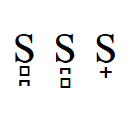| Voiceless dental fricative | |
|---|---|
| θ | |
| IPA number | 130 |
| Audio sample | |
| Encoding | |
| Entity (decimal) | θ |
| Unicode (hex) | U+03B8 |
| X-SAMPA | T |
| Braille | |
A voiceless dental non-sibilant fricative is a type of consonantal sound used in some spoken languages. It is familiar to most English speakers as the 'th' in think. Though rather rare as a phoneme among the world's languages, it is encountered in some of the most widespread and influential ones. The symbol in the International Phonetic Alphabet that represents this sound is ⟨θ⟩. The IPA symbol is the lowercase Greek letter theta, which is used for this sound in post-classical Greek, and the sound is thus often referred to as "theta".
Contents
- Features
- Occurrence
- Voiceless denti-alveolar sibilant
- Features 2
- Occurrence 2
- See also
- Notes
- References
- External links
Dental non-sibilant fricatives are often called "interdental" because they are often produced with the tongue between the upper and lower teeth, and not just against the back of the upper or lower teeth, as they are with other dental consonants.
These sounds and their voiced counterparts are uncommon as phonemes, occurring in 4% of languages in a phonological analysis of 2,155 languages. [1] Among the more than 60 languages with over 10 million speakers, only English, northern varieties of the Berber languages of North Africa, Standard Peninsular Spanish, various dialects of Arabic, Swahili (in words derived from Arabic), and Greek have the voiceless dental non-sibilant fricative.[ citation needed ] Speakers of languages and dialects without the sound sometimes have difficulty producing or distinguishing it from similar sounds, especially if they have had no chance to acquire it in childhood, and typically replace it with a voiceless alveolar fricative (/s/) (as in Indonesian), voiceless dental stop (/t/), or a voiceless labiodental fricative (/f/); known respectively as th-alveolarization, th-stopping, [2] and th-fronting. [3]
These sounds are known to have disappeared from a number of languages, e.g. from most of the Germanic languages or dialects, where it is retained only in Scots, English, and Icelandic, but it is alveolar in the last of these. [4] [5] Among non-Germanic Indo-European languages as a whole, the sound was also once much more widespread, but is today preserved in a few languages including the Brythonic languages, Peninsular Spanish, Galician, Venetian, Tuscan, Albanian, some Occitan dialects and Greek. It has likewise disappeared from many modern vernacular varieties of Arabic, like Egyptian Arabic. Standard Arabic, and various dialects like Mesopotamian Arabic still retain the sound and its voiced counterpart /ð/. Similarly, with Spanish, it is only found in most parts of Spain, including in the standard pronunciation, but has almost entirely disappeared from Latin America.
On the other hand, there are a very few languages, including Turkmen and Standard Zhuang, where these sounds have replaced /s/ and are even spelled with "s" or its orthographic equivalent.


